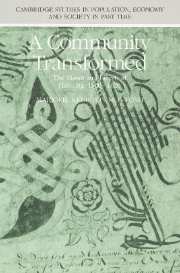Book contents
- Frontmatter
- Contents
- List of figures
- List of tables
- Acknowledgements
- Abbreviations
- Introduction
- 1 Life and death
- 2 Changing economic patterns
- 3 Religion
- 4 Facets of a society in transition
- 5 Havering's declining independence
- 6 Overt conflict, 1607–19
- Conclusion
- Appendices
- Bibliography
- Index
- Cambridge Studies in Population, Economy and Society in Past Time
2 - Changing economic patterns
Published online by Cambridge University Press: 11 October 2009
- Frontmatter
- Contents
- List of figures
- List of tables
- Acknowledgements
- Abbreviations
- Introduction
- 1 Life and death
- 2 Changing economic patterns
- 3 Religion
- 4 Facets of a society in transition
- 5 Havering's declining independence
- 6 Overt conflict, 1607–19
- Conclusion
- Appendices
- Bibliography
- Index
- Cambridge Studies in Population, Economy and Society in Past Time
Summary
Changes in Havering's economic patterns contributed to the transformation of local society and government between 1500 and 1620. At the beginning of the sixteenth century, a group of a hundred families of moderate status formed the core of the local community. They supported themselves in comfortable fashion by working yeomen's holdings or engaging in craftwork or trading activity. The heads of these families, many of which had been present in Havering for several generations, dominated office-holding in the manor, the parishes, and local charitable institutions. In regulating the maintenance of order, enforcing appropriate social behaviour, and providing poor relief, they worked co-operatively with the wealthy outsiders who had moved into Havering during the later fifteenth century. The prosperity and traditional status of these intermediate families were still solid.
As the sixteenth century progressed, however, economic divisions intensified. The proximity of London's consumer market reinforced Havering's tenurial freedom, its low rents, and an uncontrolled land market in making local agriculture profitable. Land in Havering was also attractive to wealthy families who wanted a country estate within easy reach of London. Accumulation of smaller holdings into larger composite units therefore accelerated. Some of the men responsible for this consolidation were outsiders, investing capital gained through London merchant activity, royal offices, or the law, but others were local people who were gradually reinvesting the proceeds of their own agricultural sales.
- Type
- Chapter
- Information
- A Community TransformedThe Manor and Liberty of Havering-atte-Bower 1500–1620, pp. 92 - 175Publisher: Cambridge University PressPrint publication year: 1991

